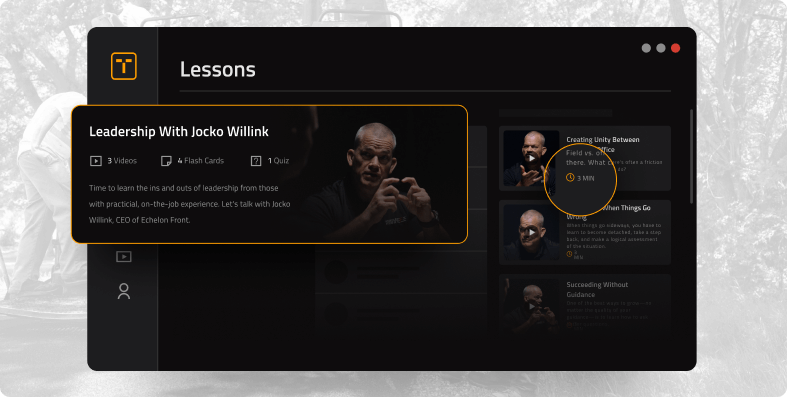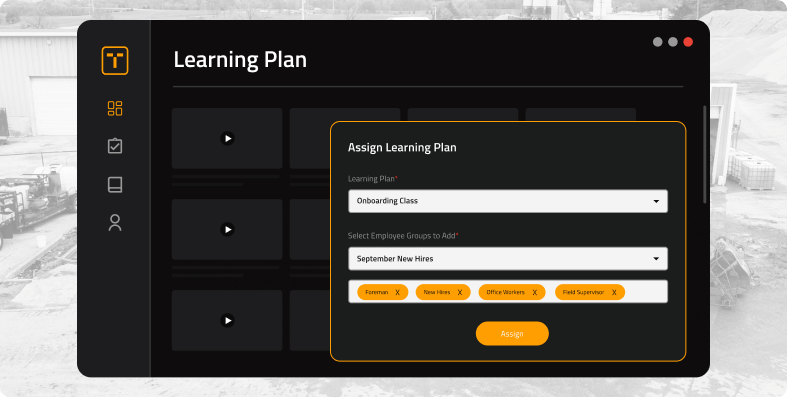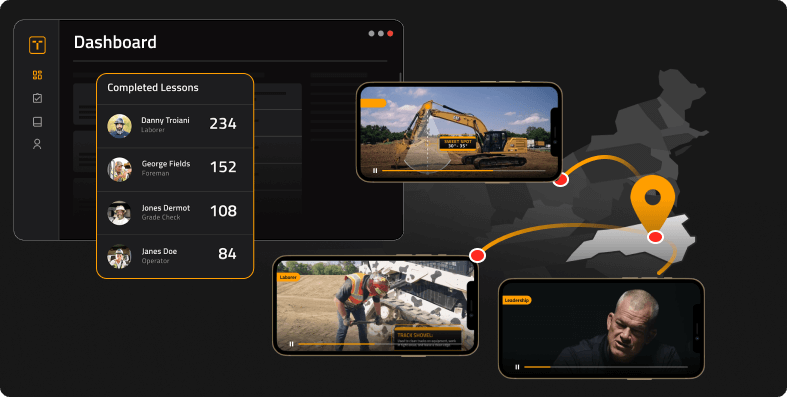How Others Are Using BuildWitt Training
Written by Megan Hamilton
March 27, 2023

Before you invest in any training product, you need a solid idea of whether it will really help you develop your people.
The best way to know how BuildWitt Training can help? See how other leaders are using it!
Here are five ways your peers in the Dirt World use BuildWitt Training to level up their people and their businesses.
Table of Contents
1. Leadership and soft skills training

Ryan Delozier, President of Geotex Construction Services, says, “We have technical skills . . . But we're not great at teaching things [like] being a good manager, having accountability—that's the stuff I think we all need to work on.”
Our customers enjoy using our 100+ preloaded leadership lessons to teach their people these soft skills.
“That’s what sets y’all apart from normal construction safety training. I love the BuildWitt library aspect,” said the Director of Safety and Employee Development at Evergreen Siteworks. “I think it’s great that I can just say, ‘Here’s 30 videos on how to be a better leader. Go.’”
Building up the next generation of leaders
Training current leaders is important. But who will take their place when they get a promotion or retire?
Our customers use BuildWitt Training to prepare people today to become the leaders they’ll depend on tomorrow. And that means training on technical knowledge and soft skills.
Brian Scivley is a Senior Project Manager and Engineering Manager at TE Stevens Construction. He told us, “There's a lot that supervisors get exposed to, in different ways . . . If they're not exposed to all of the aspects of it, it's hard to put them on a project by themselves.”
Leadership training prepares people to step into new roles safely and efficiently.
As Courtney Chroeung, Workforce Solutions Associate at UCI, points out, “Growth is people feeling comfortable in their leadership positions. Helping them grow into that position . . . is such a huge requirement.”
Resolving conflicts on the team
Mickey St. Clair, Division Operations Manager at Dragonfly Pond Works, says some managers come in with construction experience—but not pond and stormwater experience. Since they haven’t done the work before, field leaders aren’t always keen to listen to them.
Watching the leadership videos in BuildWitt Training helps get “both of those guys to gel” so they each understand where the other person is coming from. Mickey says his team is most excited about this training.
Travis McLeod from Birnam Excavating agrees that soft skills training can help prevent conflict. Instead of letting differences fester or blow up, people learn how to communicate and resolve their problems.
The best way to sum it up? Your people can have all the technical skills in the world, but if they can’t communicate with others, those skills aren’t worth a hill of beans.
As Ryan says, “Everything we do is dealing with people from your customers to general contractors or owners.”
2. Giving people ownership of their training

Kevin Wolfe has noticed that once his employees start using BuildWitt Training, they’re hungry for more.
“We've got several who have gone out on their own and watched stuff outside of this. [We’re trying to] praise them for that interest,” says Kevin, President of Haydon Bridge Company.
And he isn’t the only one encouraging people to take ownership of their education with BuildWitt Training. Here’s why others are doing the same thing.
People can develop their careers
As Travis puts it, “For go-getters—really people who want to learn—we want to have something available for them.” That’s where BuildWitt Training comes in for the Birnam crew.
And at Bachtel Excavating, newer employees can take the first steps to move up in their careers by watching lessons for the job they want to have.
Joe Sylvester from Bachtel gives this example: “Let's say a younger kid comes to me and says he wants to learn to be a dozer operator because he wants to run GPS equipment. And I say, ‘Okay, well, why don't you check out the dozer section [in BuildWitt Training]?’”
Jeff Barley, Senior Vice President at UCI, notes, “I want [my people] to make more money. I want them to go up in position, be able to provide more for their families, send their kids to college, all those types of things.”
For Jeff, it’s extremely fulfilling to watch people move from laborer to supervisor—or another role they want. BuildWitt Training is one of the tools he can use to help them do that.
People can learn as much as they want
Michelle Walker says her team at SSC Underground “really got into the leadership training and so there was almost like competition going on.” They even started certifying themselves as expert leaders.
Joe also has a foreman who’s especially into BuildWitt Training. He explains, “He watches a bunch of videos . . . he'll sit or he'll lay in bed at home and watch them. You know, when he has a little bit of time. He has a family too, but when he has some time, then he'll text me like, ‘Hey, go check this one [out].’”
You can invest in the people who want to grow
One great way to invest in your people? Simply thank them for engaging.
Jim Rhodes, Senior Vice President at Wayne Brothers, says, “Every morning I come in and look at the dashboards, and I'll shoot somebody a text . . . like, ‘Man, you watched 60 lessons in the past three weeks. I can't thank you enough.’ He didn't have 60 lessons assigned to him. He's just going to pull in those because he wants to learn more and it's engaging with him.”
Jim says that while he and other leaders still assign lessons, the people who are using BuildWitt Training so far really like it. They train voluntarily as opposed to leadership reminding them every day to “do their homework.”
So if you’re looking for ways to get your people to take ownership of their training, this could be it.
Your people can shape how you use BuildWitt Training
When you first start using BuildWitt Training—or any training product—you’ll run across people who want to help you test it, improve how you use it, and encourage others to use it, too.
These advocates can be anyone on your team, and you may even find it helpful to recruit people to be part of a “pilot group” that tries BuildWitt Training before you offer it to the whole team.
At SSC Underground, Michelle says, “We had a couple guys who were on light duty coming off of injury. So they were my beta testers . . . They loved it. It was really great. And they helped a lot . . . with identifying what would be most useful for people.”
TE Stevens rolled BuildWitt Training out slowly. They told people about it in a meeting. Then Brian says, “We picked three or four guys who we had good confidence in that they would be watching the videos with the intent to apply what they've learned.”
That initial rollout went well. And now, those field supervisors have freedom to use BuildWitt Training to help their crews. They’ll watch the videos and share the content their team needs.
3. Training more often

One great question we get is, “How often should my people use BuildWitt Training?”
And that’s a great question to ask. You want to train as much as you can, without pulling people off the job.
Jeff says that at UCI, “One of our core values is to grow together. [But] training is difficult to do, especially when you're spread out like we are. I worked here when we did all our work in the surrounding area. You could bring everybody back on a Friday and you could do training. We can't do that now. So we have to figure out a different way to do it.”
BuildWitt Training is the different way. It helps you train spread-out teams and train them far more often than you can in person.
There are two main schools of thought. One is to ease people in with regular training, spread out over a period of time so they don’t get overwhelmed. The other is to do fewer lessons at once—but do them daily so people get in the habit of using BuildWitt Training.
Here’s how frequently our customers train and why.
Weekly
Assigning weekly videos has quadrupled Dragonfly’s training frequency.
Mickey says, “It's a lot easier to get it out now. Previously it was just once a month, and we would all meet together and go through the topics. Now . . . we like to assign them a due date, like once a week, and put two videos or three videos or a course or a learning plan, however that looks.”
Weekly due dates help with accountability, because you can send a video to every person, instead of sending it to the foreman and hoping they show it. You can also track whether people watched the video or not.
Joe at Bachtel also assigns weekly training, “and then on the day that it's actually due, they have a toolbox talk at the back of their truck.”
Then, people don’t feel like they have to watch a video every day if they’re working long hours. Plus, the foreman can tell people when the training is due. Then, they can watch it on their own or put one phone on a tailgate so everybody can watch it together.
Weekly assignments are a perfect way to enhance toolbox talks. In fact, we're making a BuildWitt Training learning plan to help foremen and field supervisors level up their toolbox talks, keep crews safe, and develop them as whole people—not just productive robots.
Daily
Kevin and his leadership team at Haydon Bridge have taken a different approach.
“What we're trying to do is build the habit. So we're assigning two videos a day,” he explains.
And he’s not just talking about it. He’s doing it right along with his people: “I watch my two videos in the morning. Either I listen to them on my drive, or first thing in the morning when I get to the office or wherever I'm going.”
4. Onboarding

Travis believes BuildWitt Training provides the basic skill and technical training for entry level new hires at Birnam. And he plans to use it as a stop-gap when there’s a delay in getting workers the union training they need.
Travis explains that union training is often only available twice a year. He points out, “Well, if [new hires are] not in one of those programs, then they have to wait six months to get into it again. So this is some type of training we can give them in the meantime while they're getting seat time. This can help them with some tips, tricks, and basics.”
Here are a couple more popular ways to use BuildWitt Training for onboarding.
As part of their orientations
Ryan says, “Our orientation is a one-day process. So we’re going to have them watch a couple of videos, at least show them the platform.”
That way, new hires will be geared up and ready to use BuildWitt Training as part of their regular learning system once they’re on the job.
Upskilling experienced new hires
When Joe hired a new—but experienced—crew member at Bachtel Excavating, he knew that person needed different onboarding than a rookie.
“This guy has experience, so we needed to kind of revamp [onboarding] for somebody who actually has been in the construction industry before. So we revamped it a little bit . . . and we did it over five weeks instead of five days,” he says.
Why five weeks?
“We didn't want to overwhelm anyone,” Joe explains.
Experienced crew members have technical skills to use in the field, so they don’t need as many BuildWitt Training lessons upfront to get started. It’s more about refreshing what they know and teaching them your way of working.
This way, they won’t be loaded down with training assignments—so they can still work a full shift on the jobsite.
5. Sharing their own content

We’ve talked about why creating your own content is worthwhile before, so we won’t spend a ton of time here.
But it’s worth mentioning because our customers are using BuildWitt Training to store and share their own training content.
Joe has a foreman at Bachtel who’s “really into BuildWitt Training and really into the training side of everything . . . He made a whole video series of [our procedures] at one point, and we published it, and then he's started to do some other ones.”
And he’s not alone. Our customers have created and uploaded over 700 of their own lessons!
It’s not about who can produce the most expensive, high-end videos. It’s about using BuildWitt Training as a tool to get your crew members the education they need so they can uphold your unique way of working.
Evergreen's safety director summed it up best: “If I'm willing to do the work, then it's easy to get it into the guys’ hands. We're not trying to just do it to do it, but eventually, we hope that our evergreen library competes with the amount of data in the BuildWitt library.”
Takeaways
When you’re deciding on a new training product, it’s important to know what you can do with it. And the best way to find out? See what your peers are doing!
To recap, here are five ways other Dirt World leaders are using BuildWitt Training to develop their people:
- Leadership and soft skills training
- Giving people ownership of their training
- Training more often
- Onboarding
- Sharing their own content
Ready to give BuildWitt Training a try? Get started today.
Already a customer? Log into your BuildWitt Training account to assign lessons, upload content, and keep helping your people grow.





